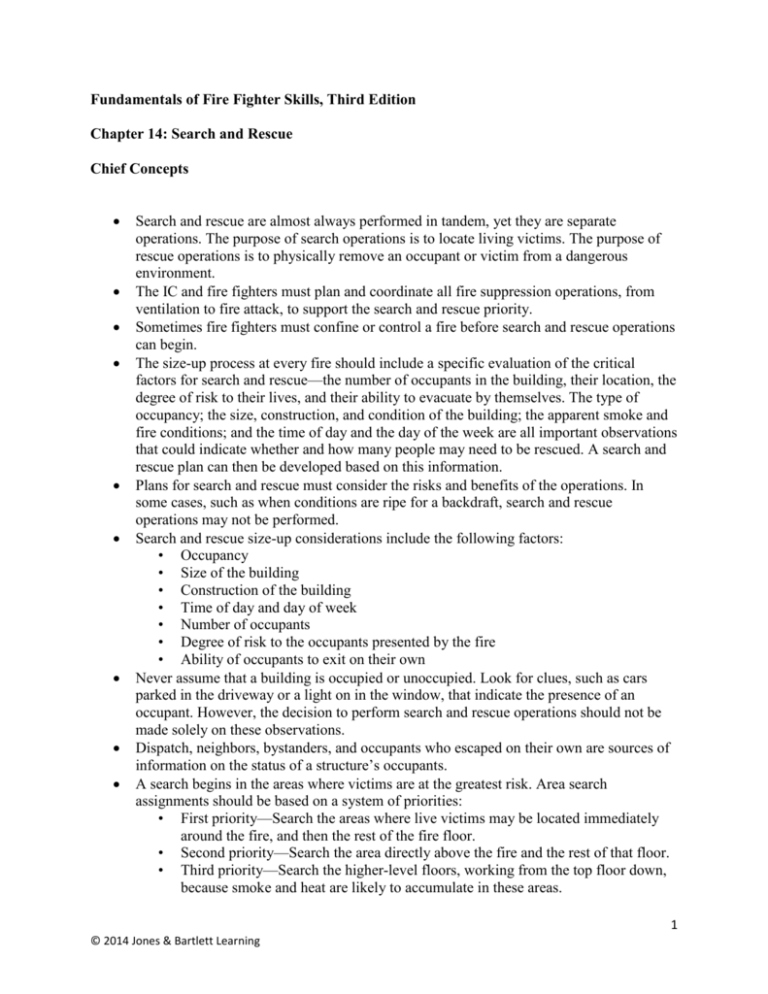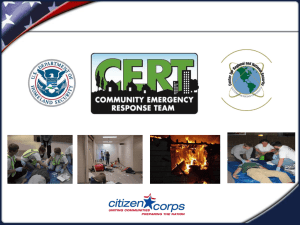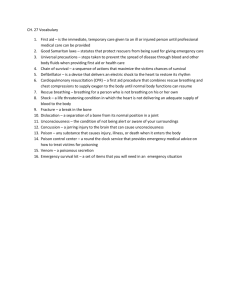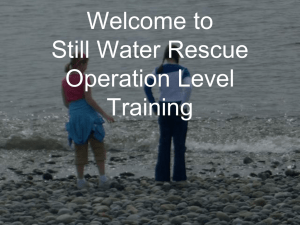Chapter 14: Search and Rescue - Fundamentals of Fire Fighter
advertisement

Fundamentals of Fire Fighter Skills, Third Edition Chapter 14: Search and Rescue Chief Concepts Search and rescue are almost always performed in tandem, yet they are separate operations. The purpose of search operations is to locate living victims. The purpose of rescue operations is to physically remove an occupant or victim from a dangerous environment. The IC and fire fighters must plan and coordinate all fire suppression operations, from ventilation to fire attack, to support the search and rescue priority. Sometimes fire fighters must confine or control a fire before search and rescue operations can begin. The size-up process at every fire should include a specific evaluation of the critical factors for search and rescue—the number of occupants in the building, their location, the degree of risk to their lives, and their ability to evacuate by themselves. The type of occupancy; the size, construction, and condition of the building; the apparent smoke and fire conditions; and the time of day and the day of the week are all important observations that could indicate whether and how many people may need to be rescued. A search and rescue plan can then be developed based on this information. Plans for search and rescue must consider the risks and benefits of the operations. In some cases, such as when conditions are ripe for a backdraft, search and rescue operations may not be performed. Search and rescue size-up considerations include the following factors: • Occupancy • Size of the building • Construction of the building • Time of day and day of week • Number of occupants • Degree of risk to the occupants presented by the fire • Ability of occupants to exit on their own Never assume that a building is occupied or unoccupied. Look for clues, such as cars parked in the driveway or a light on in the window, that indicate the presence of an occupant. However, the decision to perform search and rescue operations should not be made solely on these observations. Dispatch, neighbors, bystanders, and occupants who escaped on their own are sources of information on the status of a structure’s occupants. A search begins in the areas where victims are at the greatest risk. Area search assignments should be based on a system of priorities: • First priority—Search the areas where live victims may be located immediately around the fire, and then the rest of the fire floor. • Second priority—Search the area directly above the fire and the rest of that floor. • Third priority—Search the higher-level floors, working from the top floor down, because smoke and heat are likely to accumulate in these areas. 1 © 2014 Jones & Bartlett Learning • Lowest priority—Search areas below the fire floor. A primary search is a quick attempt to locate victims who are in danger. It should be completed in 15 minutes or less. Fire fighters must rely on their senses such as touch, hearing, and sight as they search for victims in smoky conditions. When searching a room, fire fighters should use the walls to orient themselves and as guides around the room. The room should be searched in a systematic pattern. Thermal imaging devices may be used to search for victims in darkness or smokeobscured conditions. The thermal imaging device detects the temperature differential of the victim’s body from the room. Search ropes may be used in large, open areas so fire fighters may maintain their orientation while searching for victims. The vent–entry–search method uses a window as the entry and exit point to a room. A secondary search is conducted after the fire is under control or fully suppressed. It is a slower search that is designed to locate any deceased victims and search any areas not covered in the primary search. Although every emergency operation involves a degree of unavoidable, inherent risk to fire fighters, during search and rescue operations fire fighters will probably encounter situations that involve a significantly higher degree of personal risk. Assuming this level of risk is acceptable only if there is a reasonable probability of saving a life. In some cases, the IC may decide that the risk to fire fighters is too great and a primary search may not be conducted. Sagging walls, chipped or cracked mortar or cement, warped or failing structural steel, and any partial collapse are significant indicators of an impending collapse. Dark black turbulent smoke, blackened windows, the appearance of a “breathing” building, and intense heat are signs of possible flashover or backdraft. Rescue is the removal of a located person who is unable to escape from a dangerous situation; it is the second component of search and rescue. When you locate a victim during a search, you must direct, assist, or carry that person to a safe area. Rescue can be as simple as verbally directing an occupant toward an exit, or it can be as demanding as extricating a trapped, unconscious victim and physically carrying that person out of the building. Children and elderly persons, physically or developmentally handicapped persons, impaired people, and ill or injured persons may be unable to escape from a structure and, therefore, may need to be rescued. Victims also may become trapped when a rapidly spreading fire, an explosion, or a structural collapse cuts off potential escape routes. Because fires threaten the lives of both victims and rescuers, the first priority is to remove the victim from the fire building or dangerous area as quickly as possible. In some situations, the best option is to shelter the occupants in place instead of trying to remove them from a fire building. This option should be considered when the occupants are conscious and are found in a part of the building that is adequately protected from the fire by fire-resistive construction and/or fire suppression systems. Such a situation occurs in a high-rise apartment building when a fire is confined to one apartment or one floor. The simplest rescue is the exit assist, in which the victim is responsive and able to walk without assistance or with very little assistance. Two types of assists can be used to help responsive victims exit a fire situation: • One-person walking assist 2 © 2014 Jones & Bartlett Learning • Two-person walking assist Four simple carry techniques can be used to move a victim who is conscious and responsive, but incapable of standing or walking: • Two-person extremity carry • Two-person seat carry • Two-person chair carry • Cradle-in-arms carry The most efficient method to remove an unconscious or unresponsive victim from a dangerous location is a drag. Five emergency drags can be used to remove unresponsive victims from a fire situation: • Clothes drag • Blanket drag • Webbing sling drag • Fire fighter drag • Emergency drag from a vehicle When using an emergency drag, make every effort to pull the victim in line with the long axis of the body to provide as much spinal protection as possible. The victim should be moved head first to protect the head. Assisting someone down a ground ladder carries a considerable risk of injury to both fire fighters and victims. Whenever it is possible to use a stairway, fire escape, or aerial tower for rescue, these options should be considered before using ground ladders. 3 © 2014 Jones & Bartlett Learning






